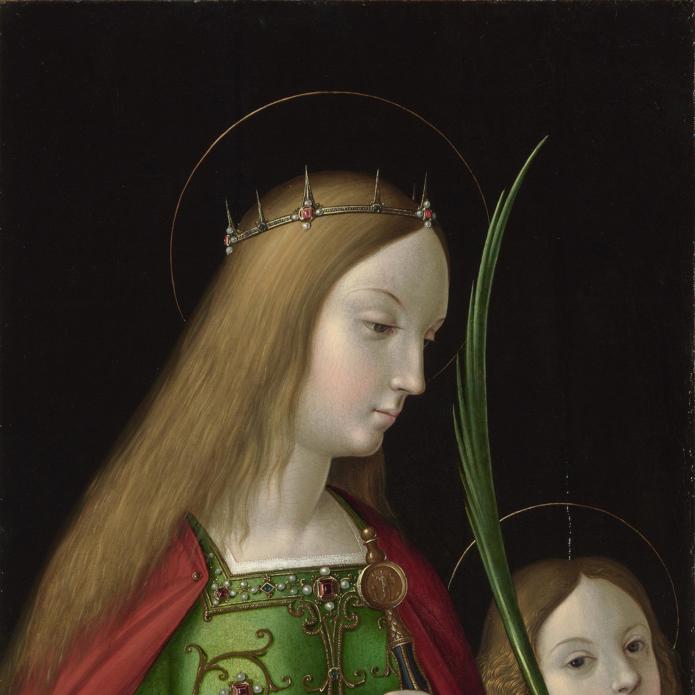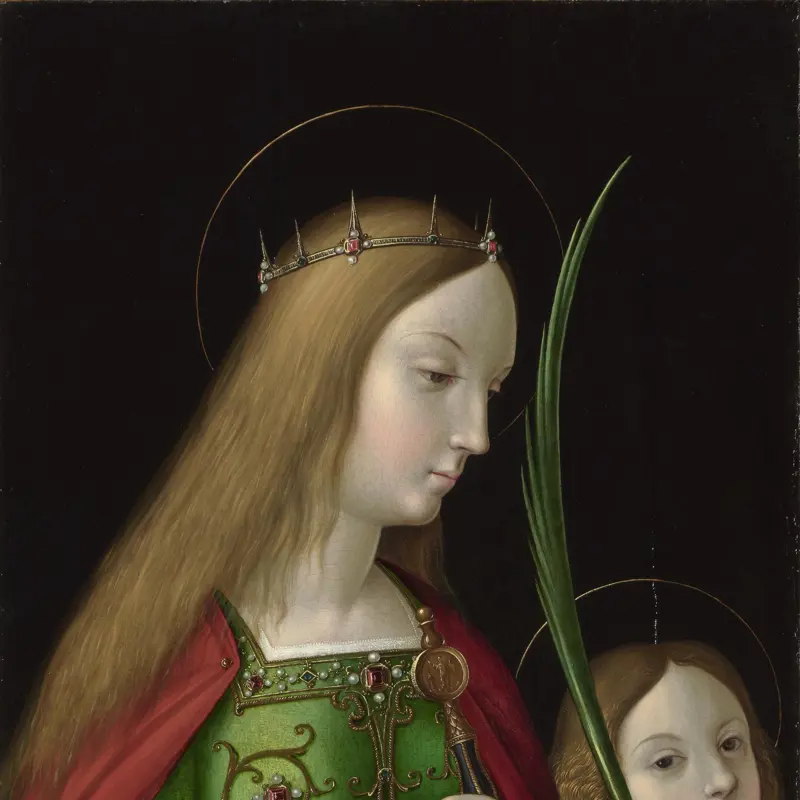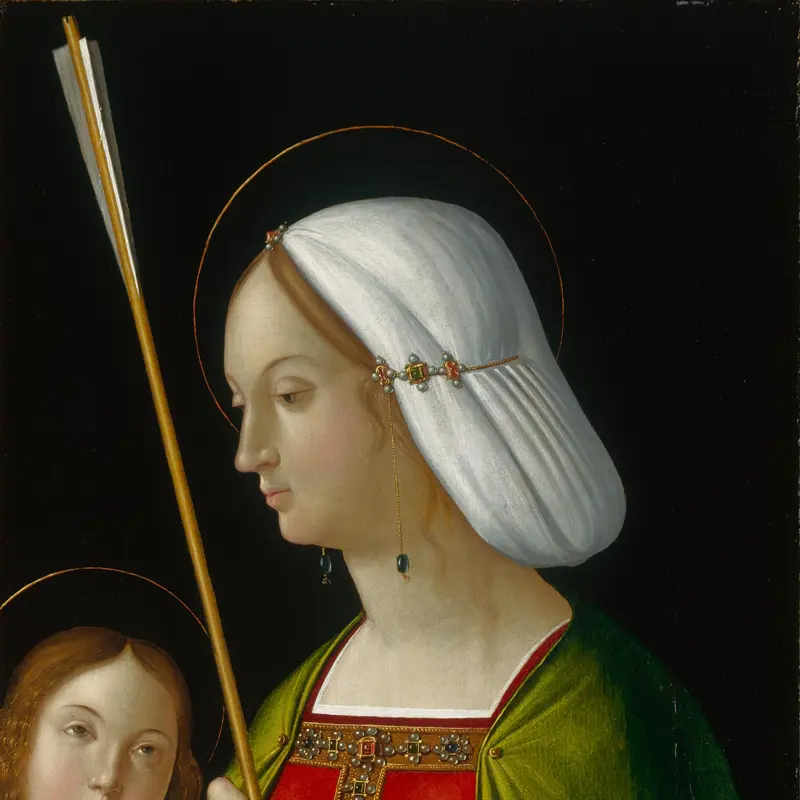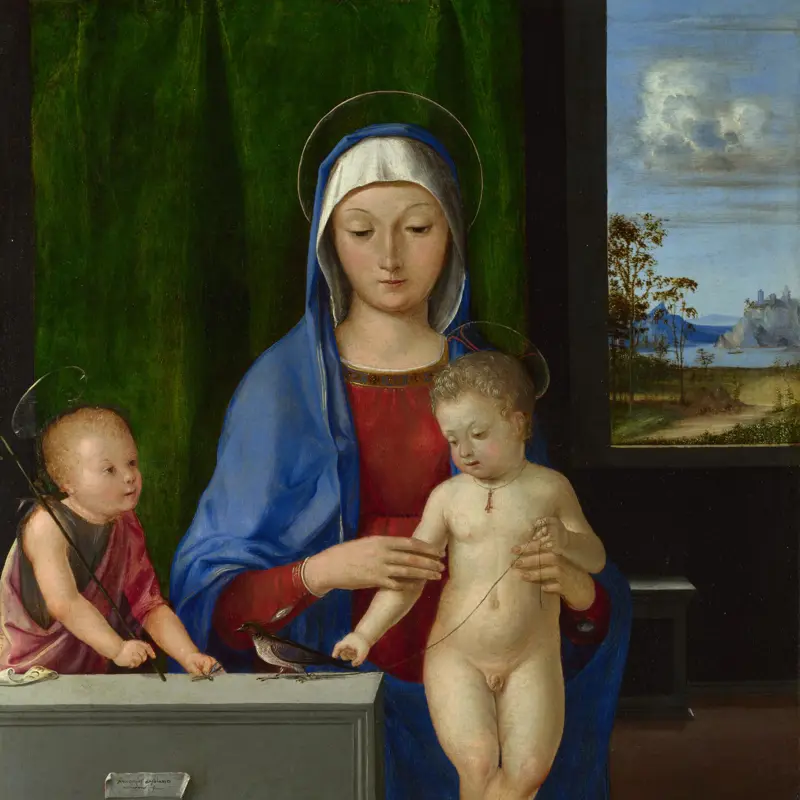Antonio de Solario, 'Saint Ursula', 1514
About the work
Overview
This panel shows Saint Ursula, and was once the right-hand shutter of a three-part folding altarpiece made for Paul Withypool, an English merchant and courtier. The opposite shutter, also in the National Gallery’s collection, shows Saint Catherine, while the central panel (in Bristol Museums and Art Gallery) shows Withypool in prayer before the Virgin and Child.
Ursula married a pagan prince on the condition that he convert to Christianity and allow her a pilgrimage to Rome. According to legend, she was accompanied by 11,000 virgins. On their return via Cologne they were all slaughtered by the Huns who were besieging the city, after Ursula refused to marry their leader.
On the panel’s reverse are two cherubs holding a medallion containing an image of Saint Paul, the donor’s patron saint. The coat of arms of the Withypool family are below.
Key facts
Details
- Full title
- Saint Ursula
- Artist
- Antonio de Solario
- Artist dates
- probably active 1502 - 1518
- Part of the series
- Wing Panels from the Withypoll Triptych
- Date made
- 1514
- Medium and support
- oil on wood
- Dimensions
- 84 × 40 cm
- Inscription summary
- Dated
- Acquisition credit
- Bought, 1860
- Inventory number
- NG647
- Location
- On loan: Long loan to Bristol Museum and Art Gallery (2024 - 2027), Bristol City Museum and Art Gallery, Bristol, UK
- Collection
- Main Collection
Provenance
Additional information
Text extracted from the ‘Provenance’ section of the catalogue entry in Martin Davies, ‘National Gallery Catalogues: The Earlier Italian Schools’, London 1986; for further information, see the full catalogue entry.
Exhibition history
-
2012Long Loan to Bristol Museum and Art Gallery (2012 - 2015)Bristol City Museum and Art Gallery1 May 2012 - 31 May 2015
-
2015Long Loan to Bristol Museum and Art Gallery (2015 - 2018)Bristol City Museum and Art Gallery1 June 2015 - 30 June 2018
-
2018Long Loan to Bristol Museum and Art Gallery (2018 - 2021)Bristol City Museum and Art Gallery1 June 2018 - 31 May 2021
-
2021Long Loan to Bristol Museum and Art Gallery (2021 - 2024)Bristol City Museum and Art Gallery1 June 2021 - 31 May 2024
-
2024Long loan to Bristol Museum and Art Gallery (2024 - 2027)Bristol City Museum and Art Gallery1 June 2024 - 31 May 2027
Bibliography
-
1951Davies, Martin, National Gallery Catalogues: The Earlier Italian Schools, London 1951
-
1986Davies, Martin, National Gallery Catalogues: The Earlier Italian Schools, revised edn, London 1986
-
2001
C. Baker and T. Henry, The National Gallery: Complete Illustrated Catalogue, London 2001
About this record
If you know more about this work or have spotted an error, please contact us. Please note that exhibition histories are listed from 2009 onwards. Bibliographies may not be complete; more comprehensive information is available in the National Gallery Library.
Images
About the series: Wing Panels from the Withypoll Triptych
Overview
These two panels once formed the shutters of an altarpiece in three parts, called a triptych. The two female saints flanked a central image signed by the artist (now in Bristol Museums and Art Gallery) which shows the Virgin adoring the infant Christ, who lays on a marble table resembling an altar. Kneeling before Christ is the man who commissioned the altarpiece, a London merchant called Paul Withypool.
Withypool was a powerful and influential person in the 1530s and 1540s; he served as a Member of Parliament from 1529 to 1536, sitting on various commissions. He was trusted as a supporter of the king’s policies. As a merchant, Withypool had connections with his Italian counterparts who, in turn, might have had something to do with Solario’s introduction to English society. Although we can't be sure, it is possible that Solario made this work while living in England.




